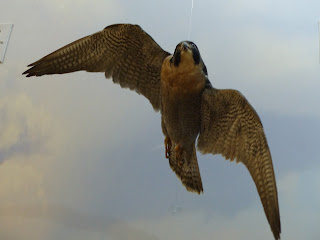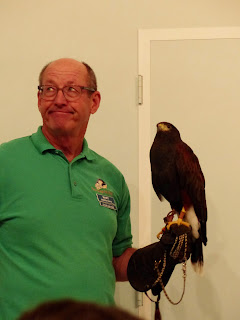 (11/10/17 - Still catching up...this is the last place we went in September.)
(11/10/17 - Still catching up...this is the last place we went in September.)We'd been through Utah several times but hadn't gone to the Great Salt Lake since our honeymoon. There's a state park out in the middle of the lake, so we decided to check it out. We drove across the Causeway to Antelope Island State Park.
You have to drive across a 7-mile long causeway to get to Antelope Island, which is the largest island in the lake.
There's a marina on the right just before the end of the causeway but this time of year there was only a single boat tied up to the dock. We drove past it to the Visitor Center, visited, then headed out to look for buffalo. (Okay, bison. I know they're bison. I grew up saying buffalo, so it slips out sometimes. I'll try to do better.)
After Yellowstone National Park in Wyoming and Custer State Park in South Dakota, the island has the largest free-roaming
John Charles Fremont mapped the island in 1843, then a few years later named it after dinner. That is, he named the island for the meat they shot for dinner there. There are still about 200 pronghorn on the island--look closely and you can see them. (Antelope are officially pronghorn--just pronghorn, not even pronghorn antelope. I have no idea why Fremont didn't call it Pronghorn Island, but it does sound kind of awkward.)
 We'd seen quite a few
We'd seen quite a few 
The Fielding Garr Ranch was established in 1848 when widower Fielding Garr and his 9 children were sent by the LDS Church to maintain the tithing herds of cattle and sheep. The church sold the ranch in 1870 and it was renamed the Island Ranching Company. It continued as a working ranch until it was sold to the state of Utah in 1981. It's pretty much as it would have been in 1973--only rustier.
We wandered around looking in the buildings, checking out the machinery, trying to figure out what some of it was used for. I knew the silo was for storing grain. George had to tell me the other thing was for stacking hay--the brochure calls it a portable "Jayhawk Stacker". It's similar to the bigger ones we saw in Montana. The giant chair is just for fun.
The original adobe ranch has has been turned into a museum.
This was a working sheep ranch, so it's no surprise to find a wagon they call a "Sheep Camp".
And, of course, if you have sheep, you have to shear them. The corrugated metal Shearing Barn was built in the 1920s. By then the island was one of the largest sheep operations in the western US. It has an engine used to power the shearing stations. I had no idea they would have been so automated, but this mechanized equipment let them shear a sheep in minutes instead of half an hour by hand. If you're shearing 10,000 sheep, that would definitely speed things up!
They could hold 1,000 head of cattle in the corrals. This is the backside of part of the building. Later they had farrowing pens for pigs, and now old trucks and farm machinery are stored there.
On the way back, we saw more buffalo bison. This big bull was sticking out his tongue, which seems like an odd thing for a buffalo bison to do. I'll ponder this some other time.






















































